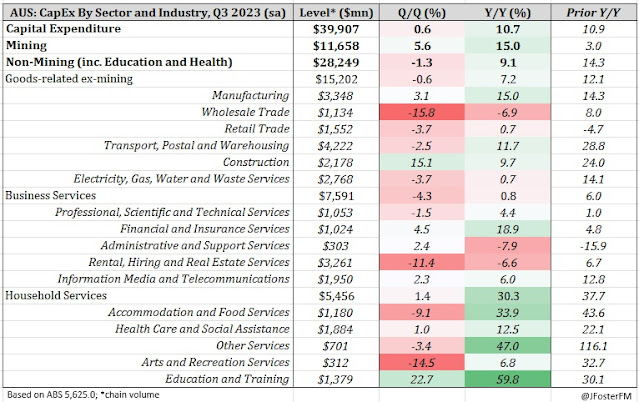Australia's National Accounts for the September quarter are due to be published by the ABS today (11:30am AEDT). Headwinds impacting household finances saw momentum in the economy slow over the first half of the year and that is expected to have continued. Real GDP growth is forecast to have remained moderate expanding by around 0.4% in Q3 and 1.8% through the year.
A recap: Economic growth remained subdued in the June quarter...
The Australian economy expanded by a subdued 0.4% in the June quarter, with year-ended growth easing from 2.4% to 2.1%. From solid growth in the back half of 2022 (1.3%), momentum in the economy slowed over the first half of the year (0.7%) as cost of living pressures and higher interest rates saw households cut back on discretionary spending.
Australia's population has increased at a rapid pace in the post-Covid period, underpinning economic growth over the past year. But this has equated to weakness in per capita growth, which contracted narrowly in quarterly (-0.3%) and year-ended terms (-0.3%). Another factor that has detracted from the quality of headline growth has been a decline in labour productivity (-3.5%Y/Y), reflecting hours worked (5.8%) expanding at a faster rate than output (2.1%). Unit labour costs have been rising as a result, highlighted by the RBA as posing a key risk to the inflation outlook.
... as headwinds continued to weigh on household spending
Household consumption came close to stalling in the June quarter (0.1%), slowing year-ended growth to 1.5%. Excluding the Covid period, this was the weakest quarterly growth rate since Q3 2019. Over the past year, household consumption has been driven by growth in essential goods and services - including rents and utilities - with pressures from the cost of living and higher interest rates prompting a winding back of discretionary purchases. This theme remained evident in Q2: essentials advanced by 0.5% as the discretionary category declined by 0.5%.
Aside from a rotation in consumption patterns, pressures on household budgets had also caused a reduction in saving. The household saving ratio declined to 3.2% in the quarter to stand at a 15-year low. However, the stock of savings accumulated by the household sector during the pandemic years remained substantial.
Services exports rebounded further and had added strongly to growth over the past year, supported by the recovery in the domestic tourism and education sectors. Business investment was defying the broader slowdown, expanding further (2.1%) on the back of momentum in equipment spending as order backlogs eased and firms took advantage of tax incentives. Residential construction activity remained weak overall (-0.2%); while new home building saw a welcome rise (1.2%), higher interest rates and ongoing capacity constraints were headwinds and alterations (-2.4%) continued to moderate from their cycle highs reached during the pandemic.
September quarter overview: Can consumption defy the headwinds?
The incoming data for the September quarter points to moderate growth in the Australian economy. Household consumption appears to have been a little stronger in Q3, supported by an improved dynamic around real incomes.
Although quarterly headline inflation lifted (1.2%q/q), wages growth accelerated (1.3%q/q) as increases decided upon by the Fair Work Commission boosted award rates and the minimum wage. Other factors that supported household consumption were the FIFA Women's World Cup and the RBA holding the cash rate unchanged at 4.1% over the quarter.
Retail sales volumes posted their first quarterly rise in a year, with broad-based increases coming through across the discretionary categories. Per capita growth in retail volumes continued to contract in Q3 (-0.5%), though at a much slower pace than in prior quarters.
Labour market conditions remained robust but have eased slightly. Employment growth had slowed to a pace that was broadly matching the rate of growth in the population, resulting in the unemployment rate rising slightly from its cycle lows late last year. But, on the whole, firms appeared to be mainly responding to the slower demand environment by adjusting hours, with hours worked contracting in the quarter.
Housing prices remained on the rise as housing supply remained tight amid rising population growth and headwinds in the homebuilding sector, outweighing the effects of higher interest rates.
Summary of key dynamics in Q3
Household consumption — Appeared to fare better in Q3, supported by a pick-up in wages growth. Retail sales volumes (0.2%) rose for the first time in a year with the discretionary categories the drivers, notably department stores (1.5%) and household goods (0.8%).
Dwelling investment — A rise in alteration work (5.1%) looked to underpin a 1.2% increase in residential construction activity in the quarter. New home building saw a modest rise (0.5%), constrained by higher interest rates and ongoing capacity constraints.
Business investment — Private sector capex slowed to a 0.6% rise in Q3 following strong momentum through the first half of the year. The expiration of tax incentives at the end of the financial year weighed on non-mining equipment investment (-0.5%).
Public demand — Increases in public spending (1.1%) and investment (2.4%) combined to contribute around 0.3ppt to quarterly output.
Inventories — Expected to add around 0.5ppt to quarterly activity, partially reversing its drag on growth in Q2 (-1.1ppts). Private non-farm inventories contributed an estimated 0.9ppt to GDP but public sector inventories were a drag at -0.4ppt.
Net exports — Estimated to deduct 0.6ppt from GDP in Q3. Imports advanced 2.1% on the back of strong services demand (8.4%) for overseas travel, while exports declined by 0.7%, weighed by resources (-4.7%).

















































